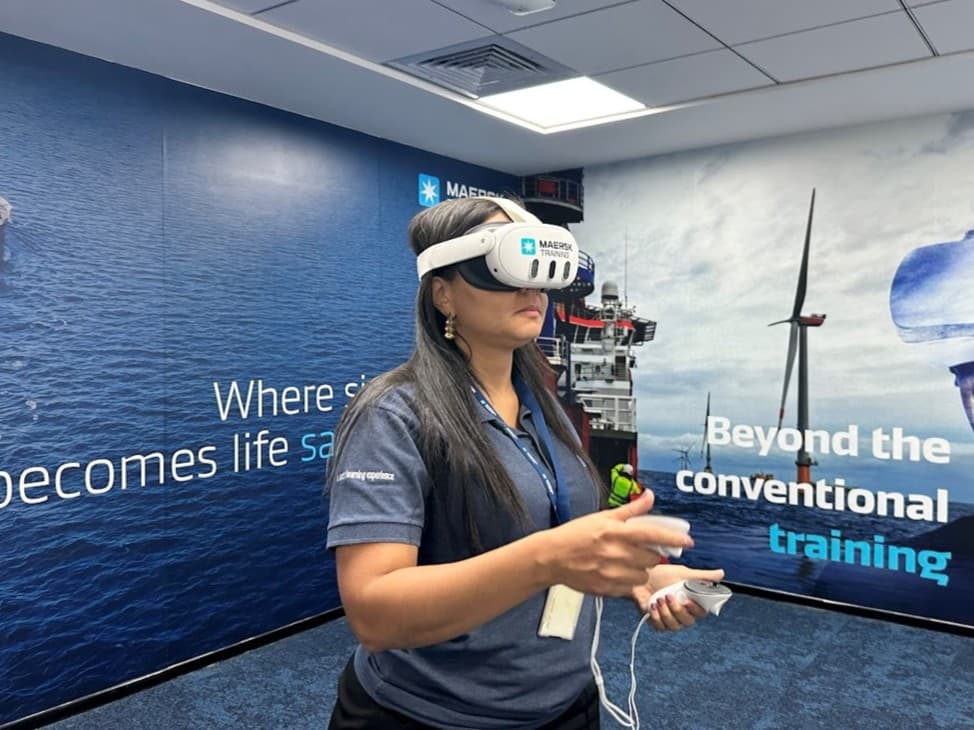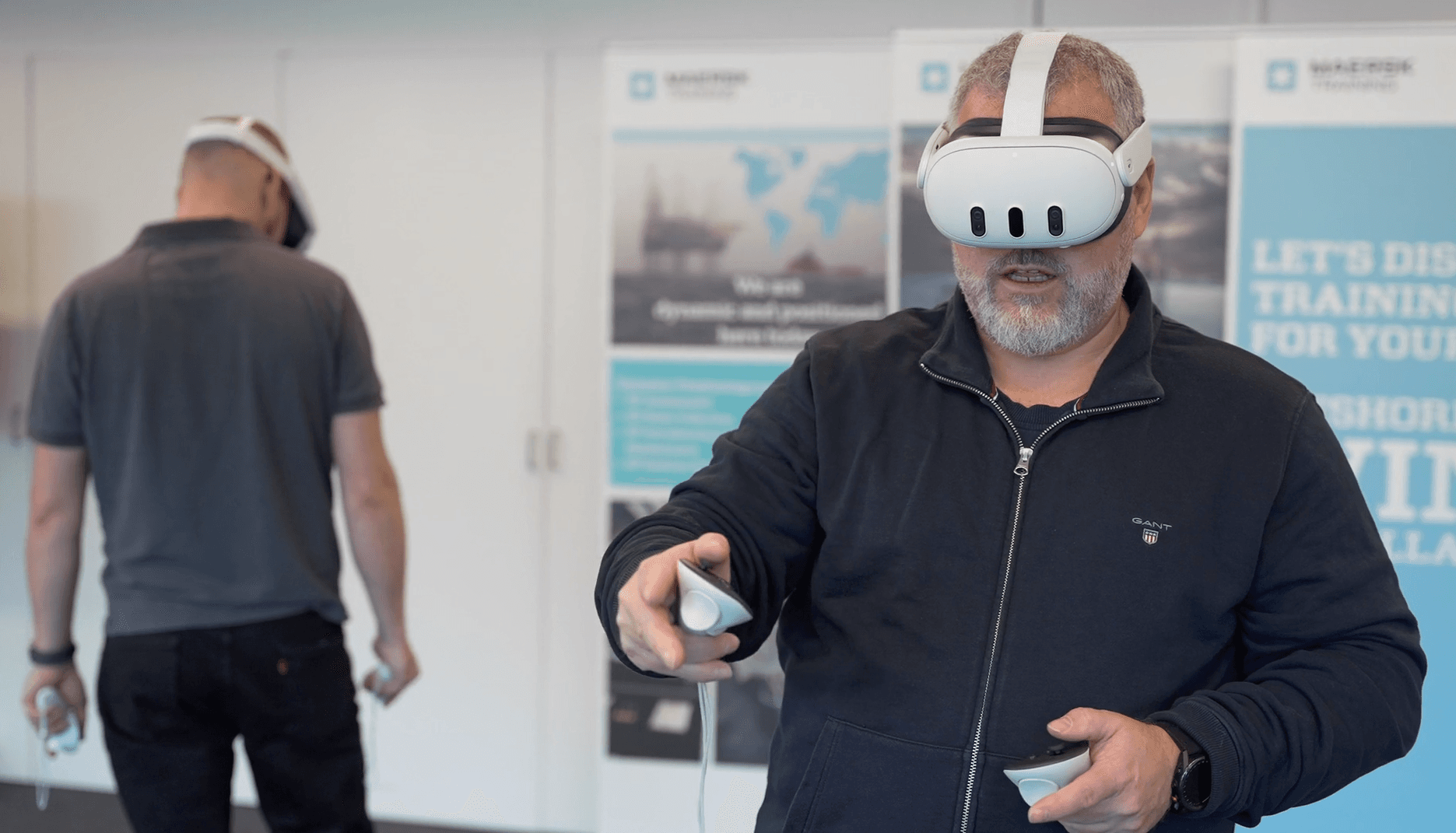Virtual Reality: hype, reality, and value in maritime and offshore training
July 2025
I had the opportunity to speak at a recent BlueTech Center event to show how virtual reality (VR) can be used for training and competence development. In this article, I share a summary of the presentation and our findings so far from the Learning & Development team here at Maersk Training.
Building lasting competence through training
For over 20 years at Maersk, including more than a decade onboard and offshore, I’ve seen how effective training shapes lasting competence. Training should never exist just to meet compliance requirements. It should build real skills that people carry into their daily work, making them safer, more confident, and more effective. Today, immersive technologies like Virtual Reality (VR) are a natural next step in this mission – but only when used correctly and with a clear purpose. The key is to focus on delivering learning value, not simply adopting technology because it looks impressive.

Evidence that VR works
The hype is real. Our experience at Maersk Training in deploying VR and immersive solutions as a delivery platform in multiple courses and programs, shows that VR works when deployed with intention and strong instructional design. This isn’t just theory – the data supports it. PwC research has shown that VR learners complete training four times faster than traditional classroom sessions, and they remain four times more focused compared to standard e-learning. Perhaps even more importantly, organisations using VR for training have seen a 43% reduction in workplace injuries.1 These figures highlight VR’s power to engage learners more deeply, improve knowledge retention, and make a tangible impact on safety.
Safe practice and global scalability
VR enables safe practice of high-risk tasks in controlled environments, so learners can make mistakes and learn from them without the danger of real-world consequences. This is especially relevant in maritime operations, where errors during procedures like mooring, firefighting, or engine maintenance can have severe outcomes. VR offers scalable, repeatable training, which is crucial when you need to train large teams across different locations consistently. It also helps reduce the need for travel, time aboard vessels, and consumption of consumable training materials, supporting both efficiency and sustainability. With VR, companies can deliver effective training both onsite and remotely, enabling access for learners regardless of location.
Our own journey with VR training began with small pilot projects focusing on safety behaviour workshops and mooring scenarios. By gathering feedback from learners and instructors, we fine-tuned our approach. Collaborations with universities like the University of Copenhagen (KU), along with trusted technology partners like SynergyXR, helped us develop and scale VR training programmes. Investments in hardware, content development, and instructor upskilling were key to moving from experimentation to a proven, reliable delivery model.

Where VR adds the most value
Today, VR adds value in several areas, some of the core applications in Maersk Training are:
-
Safety behaviour and hazard identification, including simulations of common risks and how to avoid them – where participants can experience the consequence of a failure and learn from it.
-
CO₂ firefighting, technical engine training on systems like ME and RTflex, leadership, and communication exercises that immerse learners in challenging scenarios.
Practical fire training has also become more flexible, with options to supplement centre-based sessions with home-based practice so learners can reinforce skills between courses.
The key to delivering value and moving beyond the hype is the combination of technological understanding, being strong on learning and pedagogics, and having a deep insight into the everyday life of the people we are training, so we get scenarios and training exercises anchored in realistic cases.
VR is not magic – know its limitations
One of the most important lessons we’ve learned is that VR isn’t magic. Effective VR training demands solid instructional design and realistic, relatable scenarios based on the actual tasks and challenges employees face. VR alone can’t compensate for weak learning objectives or poor content. It’s also important to recognise that VR isn’t the right tool for every situation, particularly training that depends on physical, team-based interaction or nuanced interpersonal dynamics best experienced face-to-face.
Success depends on anchoring every VR project in a clear learning strategy. Organisations must start by defining the outcomes they want to achieve, identifying the behaviours and skills that need to change or improve, and building content around those needs. Only then should they choose the technology platform. Starting with technology, rather than with clearly defined learning objectives, almost always leads to poor results, wasted investment, and frustration – a lesson we’ve also seen in decades of work with traditional full mission simulators.

The future of immersive learning
Looking forward, the future of immersive training will include AI-supported, adaptive learning experiences that adjust to each individual’s progress and needs. VR will play a growing role in certified training and assessments, helping organisations validate skills objectively. Seamless integration with Learning Management Systems (LMS) and competence systems will enable tracking of learner progress and results, while mixed reality will allow instructors or experts to support learners remotely in real-time. This approach ensures competence development remains flexible and scalable, meeting the evolving needs of maritime and offshore operations.
Make learning needs the starting point
We should always start with a thorough learning needs analysis – making sure we have clearly defined learning objectives, taxonomy, and content specifications – before we select learning platform. Thus, never start with technology (we also know this from our long experience working with simulators), which is common for deployment of edu-tech.
Identify what your team needs to do better, define measurable objectives, and develop content grounded in realistic cases. Only after that should you select the right technology. By following this approach, VR becomes a powerful tool for transformation, not a shiny distraction.
I invite you to think about your team’s most critical training gaps. Are your scenarios based on the real challenges your people face every day? What could immersive training do to help them work safer and smarter? Share your thoughts and experiences. Let’s move beyond the hype and use immersive learning to drive real change in our industry.